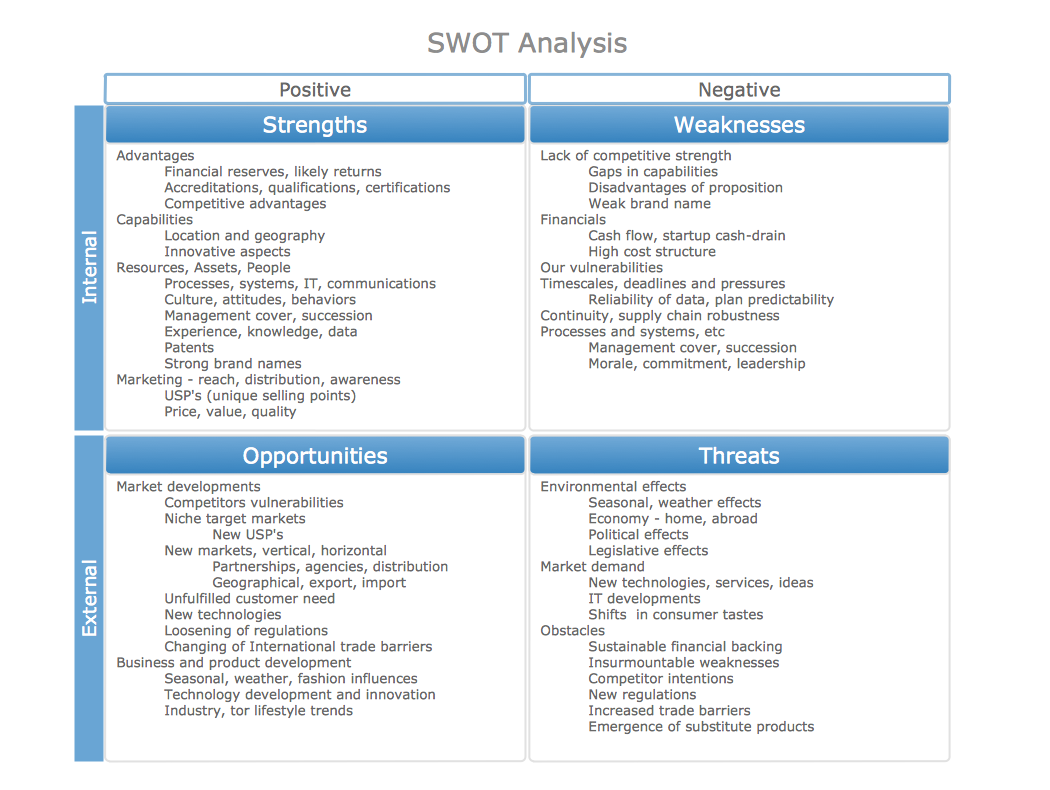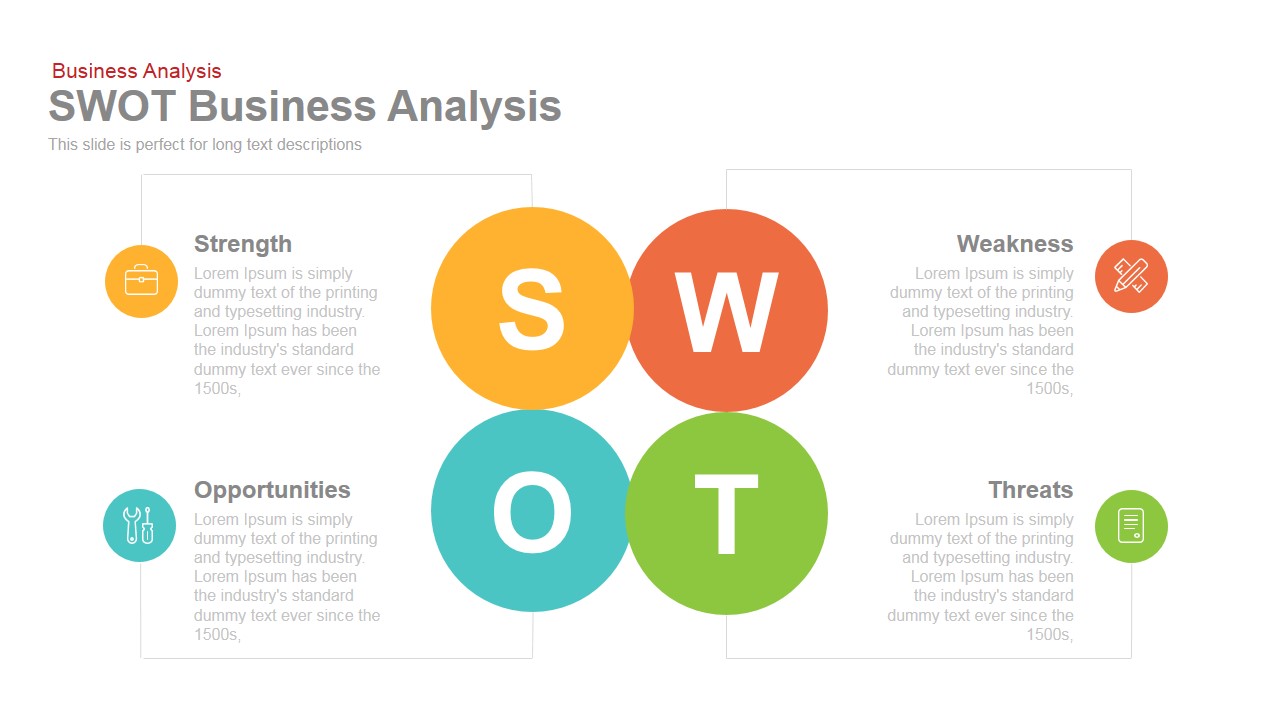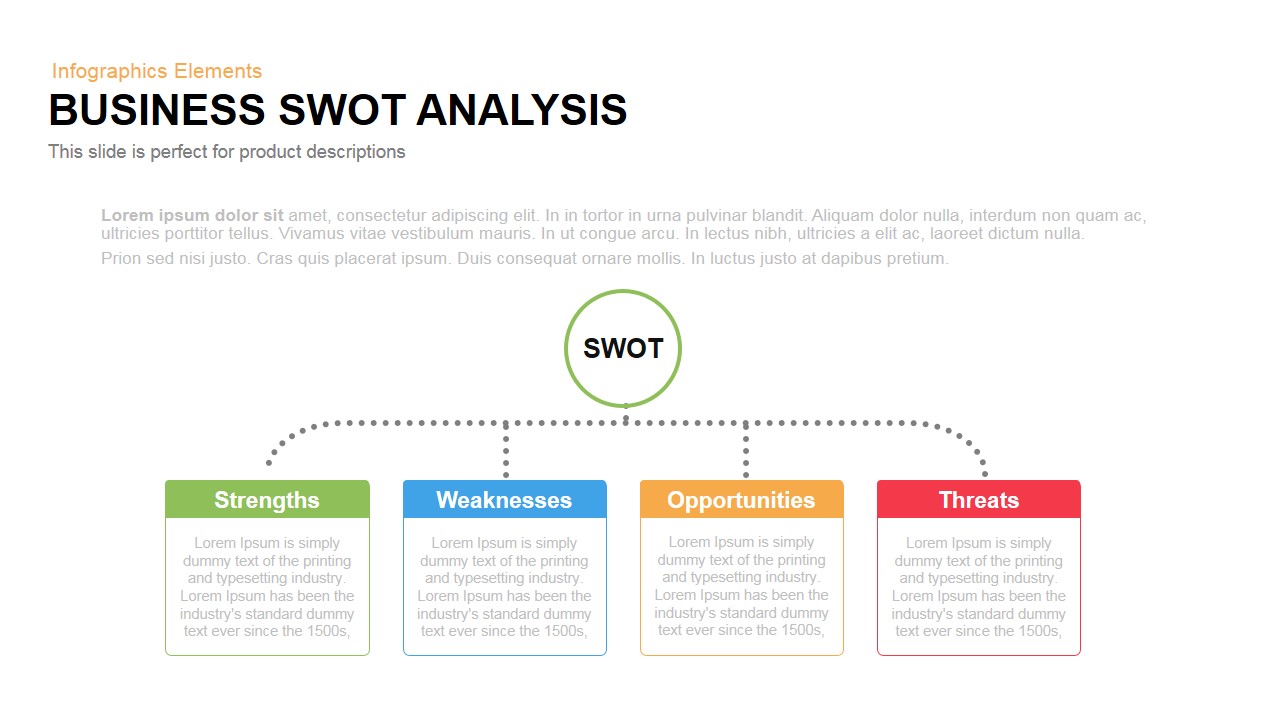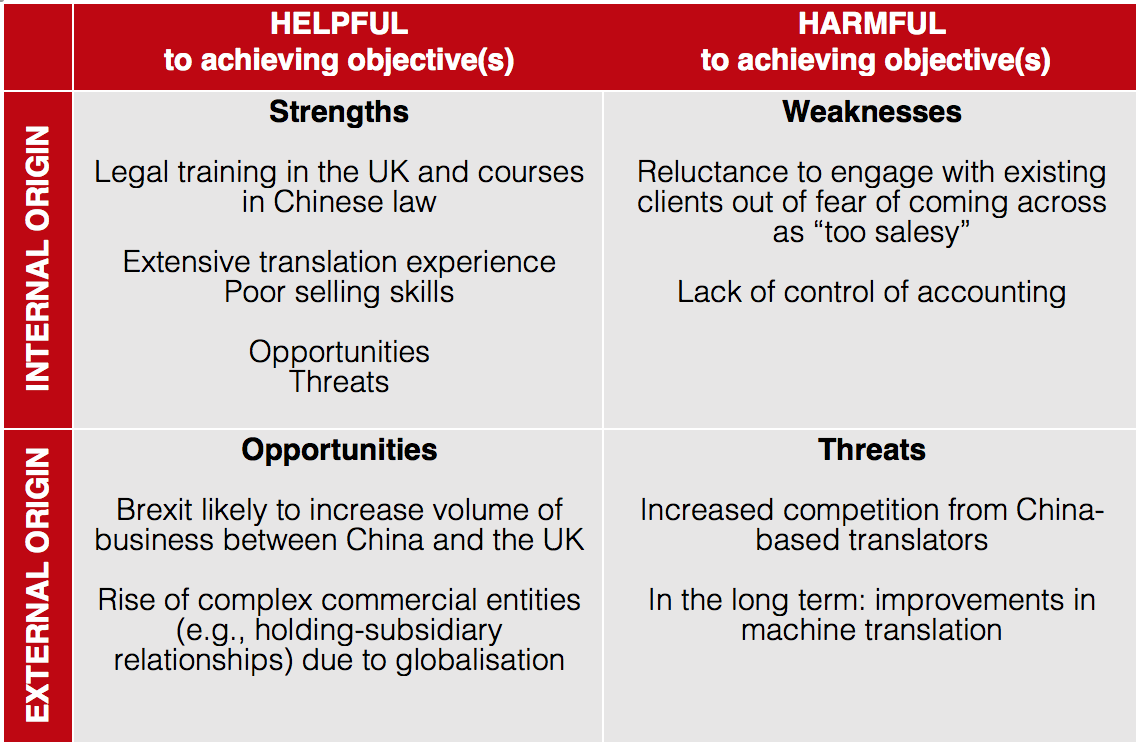A SWOT analysis is a simple tool to help you work out the internal and external factors affecting your business. It is one of the most commonly used business analysis and decisionmaking tools. A personal SWOT analysis is what you conduct to figure out the strengths, weaknesses, opportunities, and threats that are currently present in a business. By gaining all of this information, one can use all that has been gathered to see what areas of the business will need to be changed andor improved in order to reach success. The point of a SWOT analysis is to help you develop a strong business strategy by making sure youve considered all of your businesss strengths and weaknesses, as well as the opportunities and threats it faces in the marketplace. You can use a SWOT analysis in two predominant ways as a simple icebreaker helping people get together to kick off strategy formulation, or in a more sophisticated way as a serious tactical tool in the competitive sense. What makes SWOT particularly powerful is that, with a little thought. Conducting a SWOT analysis, or identifying your businesss strengths and weaknesses, as well as its potential opportunities and threats, is an essential part of any business planning process. Whether youre just getting started or have been in business for years, completing a SWOT analysis is a simple and effective way to develop smart. With business SWOT analysis, youre on the right track to keep your business on top while still planning ways to develop it, make it wellknown and competently working among other business. You can also see You can also see Marketing SWOT Analysis Templates. 9 Personal SWOT Analysis Examples. Even though SWOT analysis is primarily used in business organizations, it can also be helpful in assessing the performance of an individual. This analysis has a simple structure that can easily provide guidance. Reading an example SWOT analysis for a business that is either in your industry or based on a comparable business model can help get you started. Personally, I recommend reading at least threesince they are prioritized lists, SWOT analyses are by nature pretty short, and the more examples you look at the more likely you are to spot ideas. SWOT analysis is a method for analysing a business, its resources and its environment. It focuses on the internal strengths and weaknesses of a business (compared with competitors) and the key external opportunities and threats for the business. SWOT is perfect for business analysis because it delves into the factors that matter most, cutting right to the chase. It also reminds you, through the simple 4letter mnemonic, to include both the positive and negative factors and both the internal and external factors. Business Analysis Helps Businesses Do Business Better The Business Analyst is an agent of change. Business Analysis is a disciplined approach for introducing and managing change to organizations, whether they are forprofit businesses, governments, or nonprofits. SWOT analysis is a basic, analytical framework that assesses what an entity usually a business, though it can be a place, industry or product can and cannot do, for factors both internal. SWOT is an acronym for Strengths, Weaknesses, Opportunities and Threats. SWOT Analysis is the most renowned tool for audit and analysis of the overall strategic position of. This is a sample SWOT analysis for any category of business. It has detailed guidelines to find out the strengths and weaknesses of a business, how to convert the weaknesses into strengths, where do the opportunities lie and what are the possible threats. Examining the strengths, weaknesses, opportunities, and threats (SWOT) of a company is an integral part of strategic planning for that company. Business analysis is a research discipline of identifying business needs and determining solutions to business problems. Solutions often include a softwaresystems development component, but may also consist of process improvement, organizational change or strategic planning and policy development. Swot analysis involves the collection and portrayal of information about internal and external factors which have, or may have, an impact on business. In creating the SWOT outline, the International Institute of Business Analysis (IIBA) BABOK definition of Business Analysis will be used: According to the BABOK Guide v3, Business Analysis is the practice of enabling change in an enterprise by defining needs and recommending solutions that deliver value to. SWOT analysis, meaning Strengths, Weaknesses, Opportunities and Threats analysis, is a widely used technique to perform structured identification and analysis of the factors that will decide the outcome of any proposal, project, product or business case. A SWOT analysis is a strategic planning tool that helps a business owner identify his or her own strengths and weaknesses, as well as any opportunities and threats that may exist in a specific business situation. The SWOT analysis is a simple, albeit comprehensive strategy for identifying not only the weaknesses and threats of a plan but also the strengths and opportunities it makes possible. A SWOT analysis is a planning tool which seeks to identify the strengths, weaknesses, opportunities and threats involved in a project or business. It's a model for matching an organisation's goals, programmes and capacities to the social environment in which. The SWOT analysis is a strategic planning tool for identifying and understanding the strengths, weaknesses, opportunities, and threats affecting a business, project or situation. In fact, this tool is extremely flexible when used right and can help decision making in all sorts of circumstances. Example SWOT analysis The following is an example of a SWOT (strengths, weaknesses, opportunities and threats) analysis conducted by a business trying to decide if. The first tool on our list is a SWOT analysis and this analysis is one of the easiest and most effective to conduct. SWOT stands for Strengths, Weaknesses, Opportunities, and Threats. Strengths and weaknesses are pretty selfexplanatory and include areas which your business excels and struggles. A SWOT analysis is often created during a retreat or planning session that allows several hours for brainstorming and analysis. The best results come when the process is collaborative and inclusive. When creating the analysis, people are asked to pool their. Swot analysis is a simple and widely used analysis tool to assess business environment. It helps to understand strengths, weaknesses, opportunities and threat of a business, product and projects. It can be used for nonprofit organizations and even for individuals personal assessment. TOWS Analysis is a variant of the classic business tool, SWOT Analysis. TOWS and SWOT are acronyms for different arrangements of the words Strengths, Weaknesses, Opportunities and Threats. SWOT Analysis is a strategic management tool, which helps organizations to identify what internal and external factors are positively and negatively impacting how they operate. SWOT analysis is a business analysis process that ensures that objectives for a project are clearly defined and that all factors related to the project are properly identified. The SWOT analysis process involves four areas: Strengths, Weaknesses, Opportunities and Threats. The analysis of strengths, weaknesses, opportunities, and threats can be very beneficial to different entities. It can be an analysis of an individual, a group, an organization, or a business. SWOT analysis is a simple planning tool that compares strengths and weaknesses with opportunities and threats to create an action plan. Strengths and weaknesses are internal to the business or individual being analyzed while opportunities and threats are external factors. SWOT analysis is a technique developed at Stanford in the 1970s, frequently used in strategic planning. SWOT is an acronym for Strengths, Weaknesses, Opportunities, and Threats and is a structured planning method that evaluates those four elements of an organization, project or business venture. A SWOT analysis is a simple, but powerful, framework for leveraging the organization's. A SWOT analysis lists the good and bad things about your business, both from an internal and external viewpoint, by identifying strengths, weaknesses, opportunities and threats. Business Analysis is the discipline of identifying business needs Figure 1. 6 The McKinsey 7S model 18 Figure 1. 7 The fourview model 20 Figure 1. 8 Balanced Business Scorecard 23 Figure 2. 1 The main stages of interviewing 26 SWOT stands for Strengths, Weaknesses, Opportunities and Threats, and a SWOT analysis examines these factors for a given business, project, or personal objective. The idea is to define an objective and then use the analysis to determine what internal and external factors. Use this tool to quickly develop a set of actions to improve your business. SWOT analysis using SWOT diagrams or matrices is a key part of any business planning or analysis. SWOT stands for strengths, weaknesses, opportunities, and threats. Strengths and weaknesses are internal factors and opportunities and threats are external factors. SWOT Analysis is a very useful technique for understanding your companys STRENGTHS and WEAKNESSES. It is also useful for identifying the OPPORTUNITIES open to your business as well as the THREATS it faces. A SWOT analysis helps you take a deep look at your business from a more objective framework so you get a clearer idea of what the business does well and what it struggles with. The SWOT process also forces you to think about the future; not just tomorrow, but next year and the next five years. A Strength, Weakness, Opportunity and Threat (SWOT) analysis is a common tool in the professional world to evaluate the past, present and future position of a company. A SWOT analysis helps you analyze your companys capabilities against the realities of your business environment so you can direct your business toward areas where your capabilities are strong and your opportunities are great. There are different types of business analysis tools for both internal and external business environment. A good example is PESTLE Analysis and SWOT Analysis. Using Swot analysis example is the best way to understand this technique. The SWOT analysis is a business analysis technique that your organization can perform for each of its products, services, and markets when deciding on the best way to achieve future growth. SWOT analysis method and examples, with free SWOT template. The SWOT analysis is an extremely useful tool for understanding and decisionmaking for all. With these SWOT Analysis examples, you can easily understand how you can use this to analyze a business situation in a comprehensive way. After careful analysis, you can determine whether a new venture have enough positives in its favor to be pursued. HBR's SWOT Analysis Tool is a digital product and is intended for individual use only. To download this product after your purchase, simply signin to hbr and visit the Purchases area of your. This is a method taught in business school and used by aspiring managers to visually organize and describe the competitive landscape using Strengths, Weaknesses, Opportunities, and Threats as your key criteria. SWOT Analysis is a useful technique for understanding your Strengths and Weaknesses, and for identifying both the Opportunities open to you and the Threats you face. Used in a business context, it helps you to carve a sustainable niche in your market..











